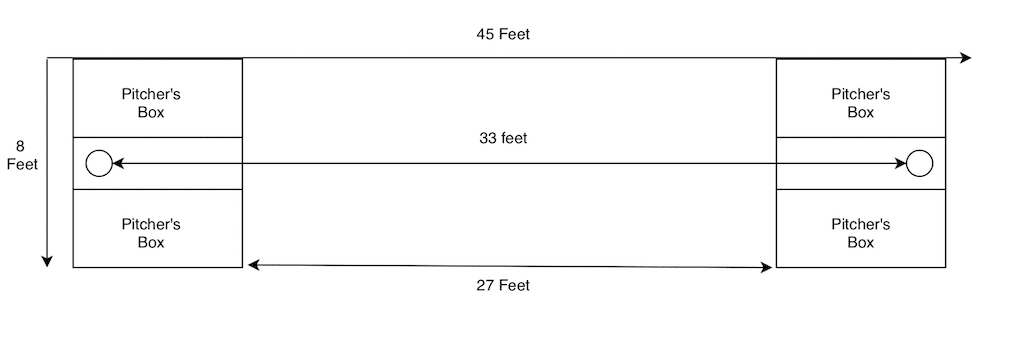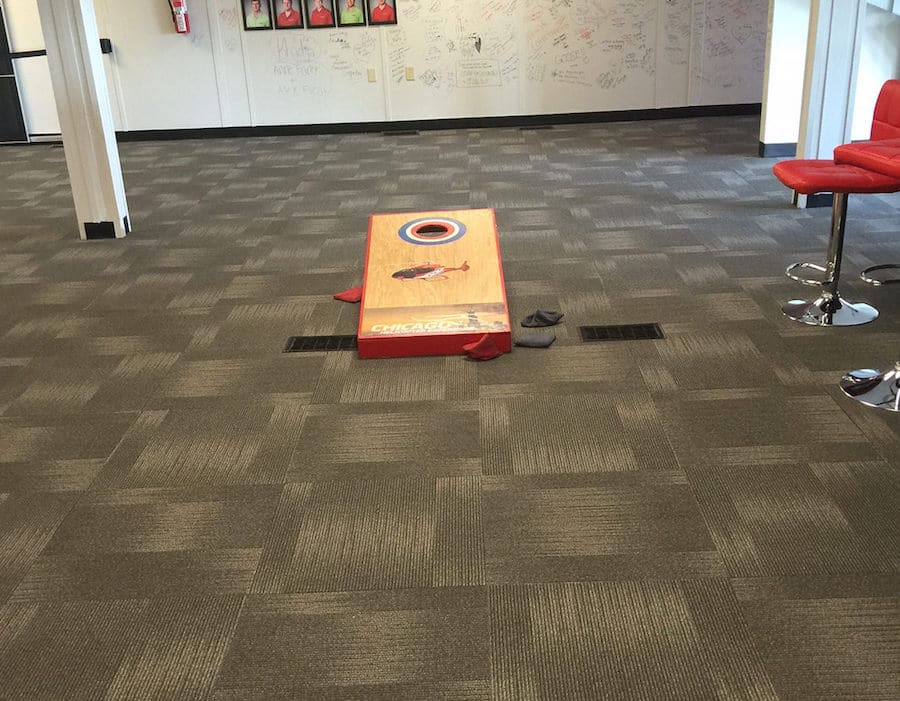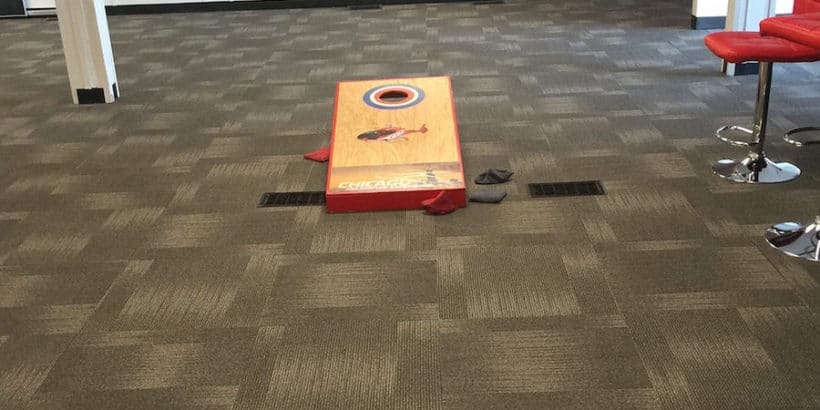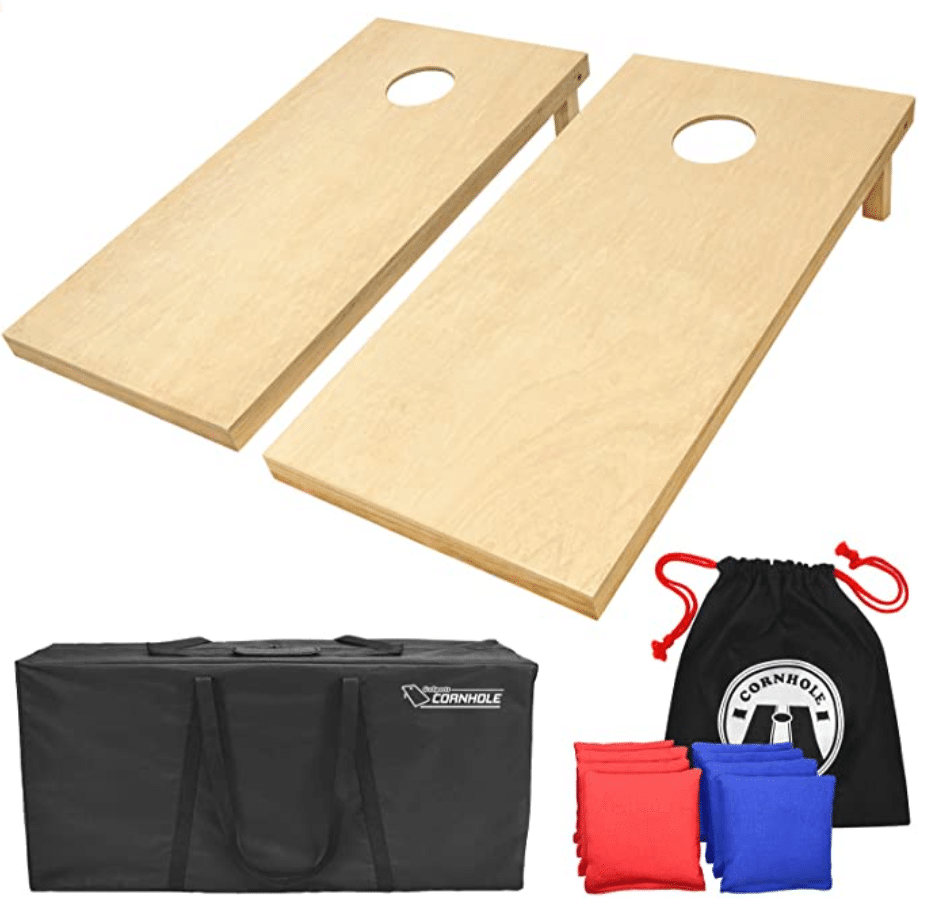Cornhole is a perfect game for the outdoors but this “lawn game” can also be played indoors as well. Whether you’re trying to find a good option for a fun game play to in the winter or you’re just curious as to how indoor cornhole would work, this article will tell you everything you need to know.
Cornhole court
An official cornhole court would be 8 feet by 45 feet according to the ACO but unless you’re playing in a conference room, gymnasium, or some other large facility, that’s going to impossible for many.
So don’t worry about setting up the full cornhole court — it’s just not necessary for indoor cornhole.

Indoor cornhole board distance: how far apart?
For a traditional game of cornhole, the boards should be 27 feet apart. In backyard and tailgate play, some people might also play 24 feet away from the boards.
But when it comes to the indoors you might have to get much closer.
The goal when playing indoor cornhole should just to play as far away as possible from the boards. I would try to find an area like a garage or basement where you can get around 15 feet away from the boards.
Tip: To expand the room that you have, consider playing with only one cornhole board. That can add you a few extra feet to play with which can make a big difference.
Get a quality cornhole board set right now!
Check out my #1 recommendation for a quality cornhole board set that is perfect for beginners.
Ceiling clearance
The next major consideration is the ceiling.
Ideally you want 12 feet of clearance between the floor and ceiling. Remember, sometimes you really want to put a good arc on the toss, depending on which cornhole technique is best for you.
Some tournaments are played with 10 feet-high ceilings but you’re starting to push it once you get below that.
Technically, if the bean bag hits the ceiling it should be a foul according the cornhole rules. However, you could always make an exception if you’re playing in tight corridors and just consider the ceiling in play like they do in some sports.

What kind of cornhole board?
A full-sized cornhole board is 4 feet by 2 feet.
Four feet by two feet might not sound like much but if you’re trying to place inside a house or garage, that can actually be pretty bulky.
You can play with full-size cornhole boards indoors if you’ve got the room but you might want to look into the smaller boards if you can’t fit a board that size indoors.
Below are my recommendations for indoor cornhole boards.
My #1 recommendation
My #1 recommendation is to go with a tailgate sized cornhole board which are usually 3 feet by 2 feet. It’s only one foot shorter but that will make a big difference indoors, especially if you’re planning on playing with two cornhole boards.
If you don’t want a wooden cornhole board they make very portable tailgate-sized cornhole boards with PVC frames which could be a lightweight alternative.
You can get cornhole boards that are much smaller than these, too.

My #2 recommendation
If you can’t go with a tailgate-sized board then my recommendation would be to go with a junior-sized cornhole board in many situations.
These re primarily made for kids and families but they also can be used for indoor venues where you just want to have a some cornhole to play.
These junior sized boards a 2 feet by 1 foot, so they’re very compact compared to a full-sized board and you could fit these things just about anywhere and even play a game in the living room. They are also very light so you could easily pull them in and out of a closet if needed.
They have even smaller boards than these.
My #3 recommendation
You can find even smaller cornhole boards that are 10 1/4 inches by 15 1/2 inches for example. These are much smaller than even a junior-sized cornhole board and so they might be too small for you if you’re trying to maintain something that feels truer to real cornhole.
Finally, there are also tabletop cornhole boards, which can fit just about anywhere. These are not going to give you a real cornhole experience since you usually set these up about two feet apart and you flip the bags at each board, almost like paper football.
It can be a fun way to pass the time or even to tie in as a drinking game but if you’re wanting something that resembles the real cornhole, this is not really a substitute.
Cornhole golf?
If you’re really pressed for space then consider playing a version of “cornhole golf.”
This is where you will have the cornhole board set up in one area of the house where it will take multiple shots to get in the hole. It’s sort of like turning your house into putt-putt golf but cornhole style.
Obviously you need to make sure you’re not going to break things around the house, but this can be an option to consider if you just don’t have the space needed for tossing cornhole bags in a direct line.
Another alternative is play “H.O.R.S.E.” where you compete to make crazy shots around the house until one player can’t replicate the shot (and make it) five times.
What kind of bags to use in indoor cornhole?
The regulation sized cornhole bags are 6 inches by 6 inches and usually weight 15 to 16 ounces. The bags are usually filled with either corn feed or plastic resin pellets and there are pros and cons to each.
If you’re just going to be using the bags indoors, then you probably don’t need weatherproof bags so you might consider going with the natural corn-filled bags.
However, they do produce a dust that settles on wherever they land and so if you don’t want corn dust settling inside then you still might want to go with the weatherproof bags which usually have plastic resin pellets.
When playing indoors with a smaller board, you may also want to go with smaller bean bags. Otherwise, the full-sized bean bags could take up too much space on your small board and effect the game play.
Is game play different?
You can score the cornhole game using the standard cornhole scoring rules and play the game in the same way that you’d normally play cornhole. Although as mentioned, you might want to reconsider what’s a foul if dealing with tight corridors.
One of the biggest differences is that you’re not going to have to deal with the wind when tossing your bag. In an outdoor game you may have to put more spin on your bag or pitch it at a lower arc to mitigate the affect of the wind.
But when playing indoors that’s not really an issue so you may not need to put as much spin on your toss. If you have enough clearance, you’ll also be able to put more arc on your shots if you’d like since the wind shouldn’t carry your shots.
Play in the dark
One thing that’s cool about playing indoors is that you can control the lighting.
If you’re having a get together or some kind of party you could always set up your cornhole board with lights and turn off the lights in the room so that the only light shining is from the cornhole board.
This will make the game a bit more unique and interesting with a different type of vibe.
Drinking games
There are a lot of cornhole drinking games you can choose from.
Final word
Indoor cornhole can definitely be a great way to play. When you have a lot of room inside a venue like a gymnasium there’s no trouble in getting a full-sized regulation cornhole set up but things are different when playing in a house, dorm, or somewhere else.
In those instances, you probably want to go with a smaller cornhole board and potentially only play with one board to maximize the distance you have. You also need to consider the height of your ceiling and whether or not you want to call fouls on bags that ceilings (or even walls).



